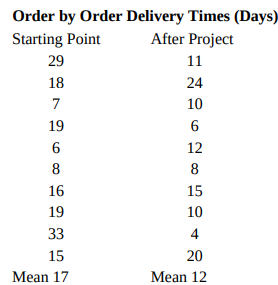One of three major strategic initiatives of General Electric Company in 1998 was Six Sigma quality. The
Question:
One of three major strategic initiatives of General Electric Company in 1998 was Six Sigma quality. The following comments were made by John Welch, former CEO of GE in the 1998 Annual Report.
“Six Sigma quality, our third growth initiative, is, in itself, a product of learning. After observing the transformational effects this science, this way of life and work, had on the few companies that pursued it, we plunged into Six Sigma with a company-consuming vengeance just over three years ago. We have invested more than a billion dollars in the effort, and the financial returns have now entered the exponential phase —more than three quarters of a billion dollars in savings beyond our investment in 1998, with a billion and a half in sight for 1999.
“The Six Sigma–driven savings are impressive, but it is the radical change in the overall measures of operating efficiency that excite us most. For years—decades—we have been straining to improve operating margin and working capital turns. Our progress was typically measured in basis points for margins and decimal points in working capital turns. Six Sigma came along in 1995 when our margins were in the 13.6 percent range and turns at 5.8. At the end of 1998, margins hit 16.7 percent and turns hit 9.2. These numbers are an indicator of the progress and momentum in our Six Sigma journey. .
“The ratio of plant and equipment expenditures to depreciation is another measure of asset efficiency. This number in 1998 dropped to 1.2 and will be in the 0.7 to 0.8 range in the future, as ‘hidden factory ?after ‘hidden factory’—literally ‘free capacity’—is uncovered by Six Sigma process improvements.
“Yes, we’ve had some early product successes, and those customers who have been touched by them understand what this Six Sigma they’ve heard so much about really means. But, as we celebrate our progress and count our financial gain, we need to focus on the most powerful piece of learning we have been given in 1998, summarized perfectly in the form of what most of our customers must be thinking, which is: ‘When do I get the benefits of Six Sigma? ‘ When does my company get to experience the GE I read about in the GE Annual Repor.
“Questions like these are being asked because, up to now, our Six Sigma process improvements have concentrated primarily on our own internal processes and on internal measurements such as ‘order-to-delivery for" shop turnaround time. ?And in focusing that way—inwardly on our processes—we have tended to use all our energy and Six Sigma science to ‘move the mean to, for example, reduce order-to-delivery times from an average of, say, 17 days to 12 days, as reflected in the example below. We’ve repeated this type of improvement over and over again in thousands of GE processes and have been rewarded for it with less "rework" and greater cash flow.

Compute a measure of the variability in the data above. From a customer’s perspective how would you view the results of Six Sigma as depicted in the example given by CEO Welch?
Step by Step Answer:

Management Accounting
ISBN: 978-0132570848
6th Canadian edition
Authors: Charles T. Horngren, Gary L. Sundem, William O. Stratton, Phillip Beaulieu





